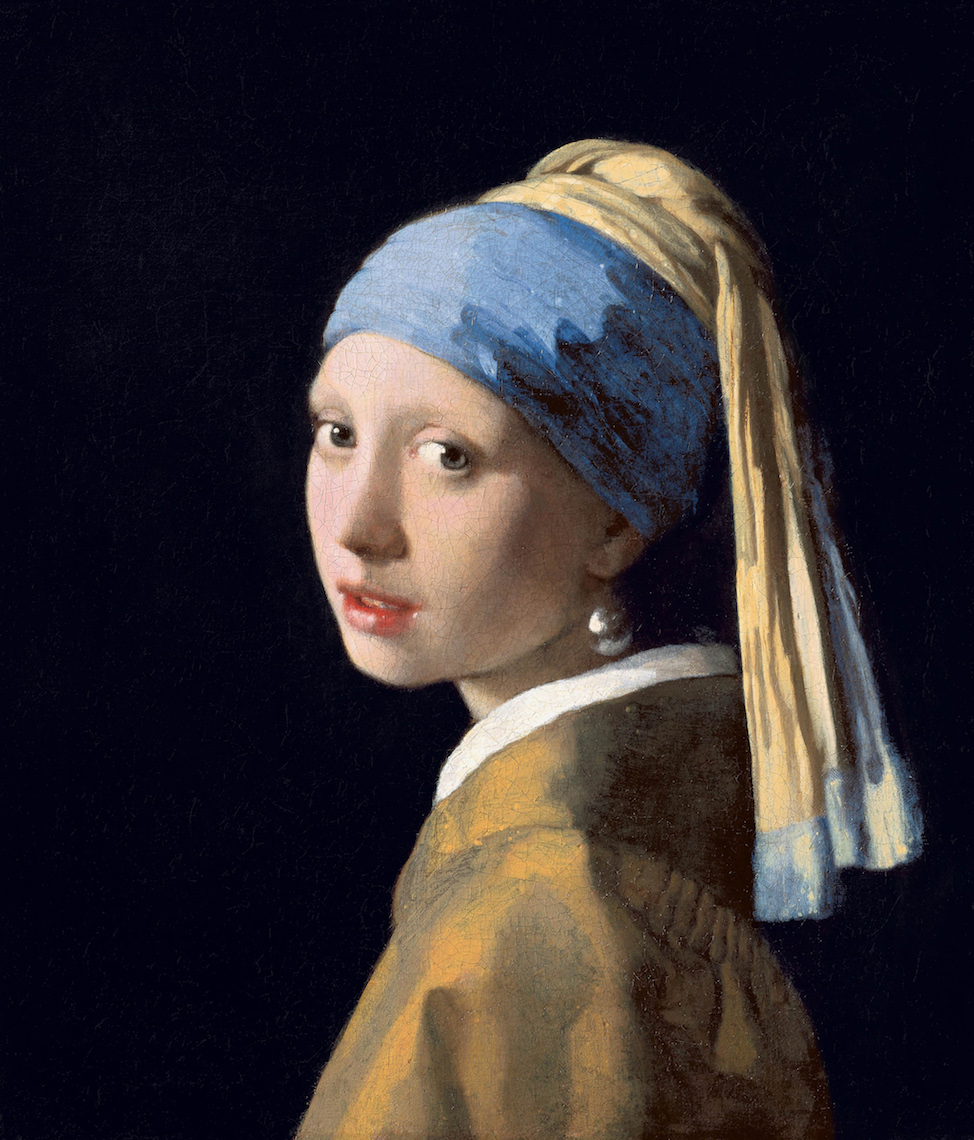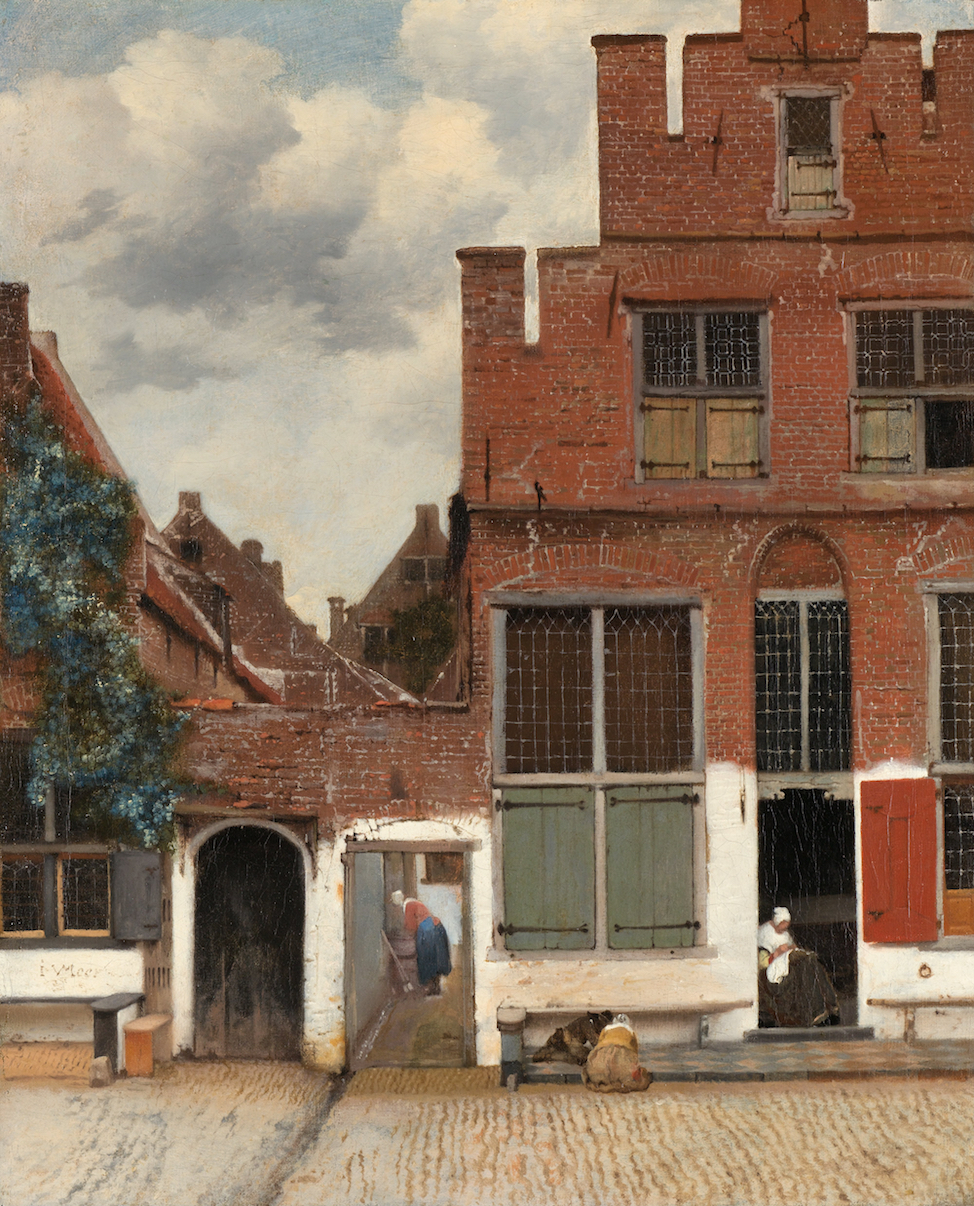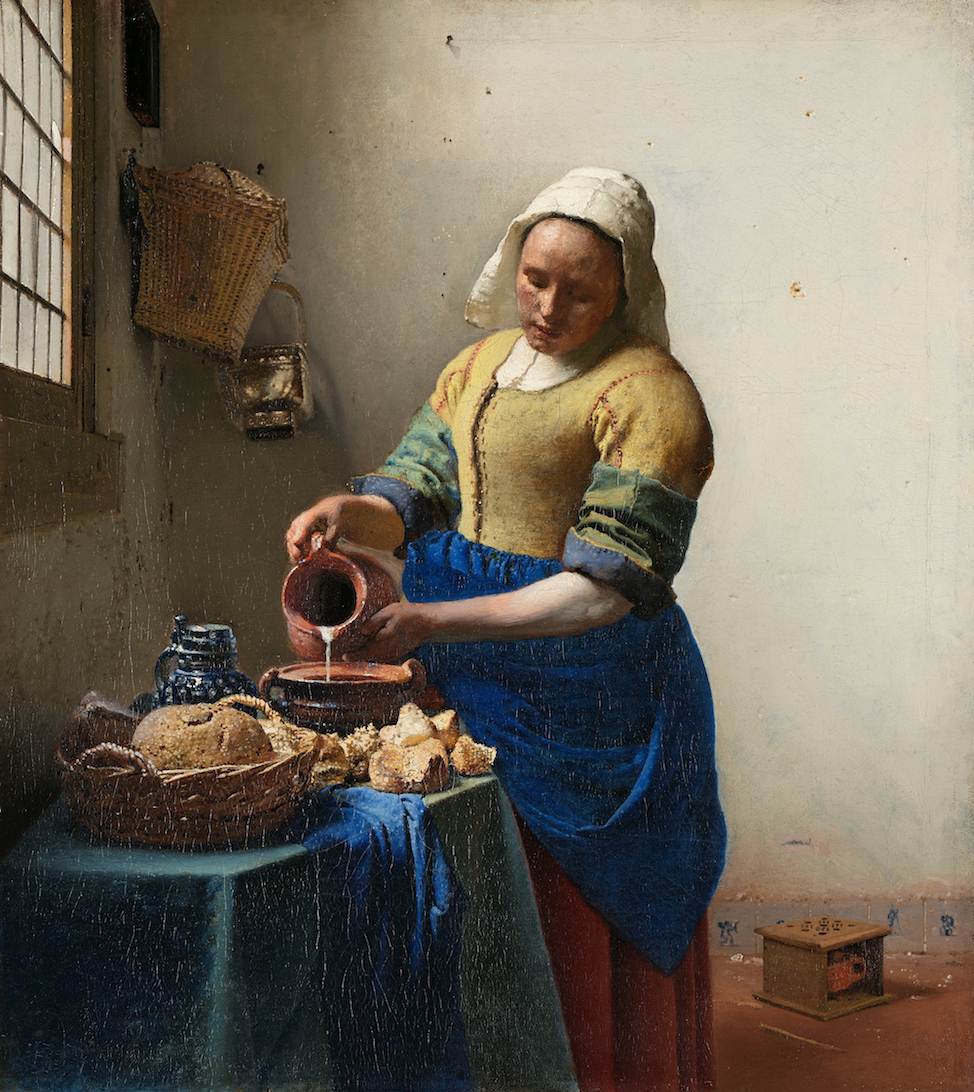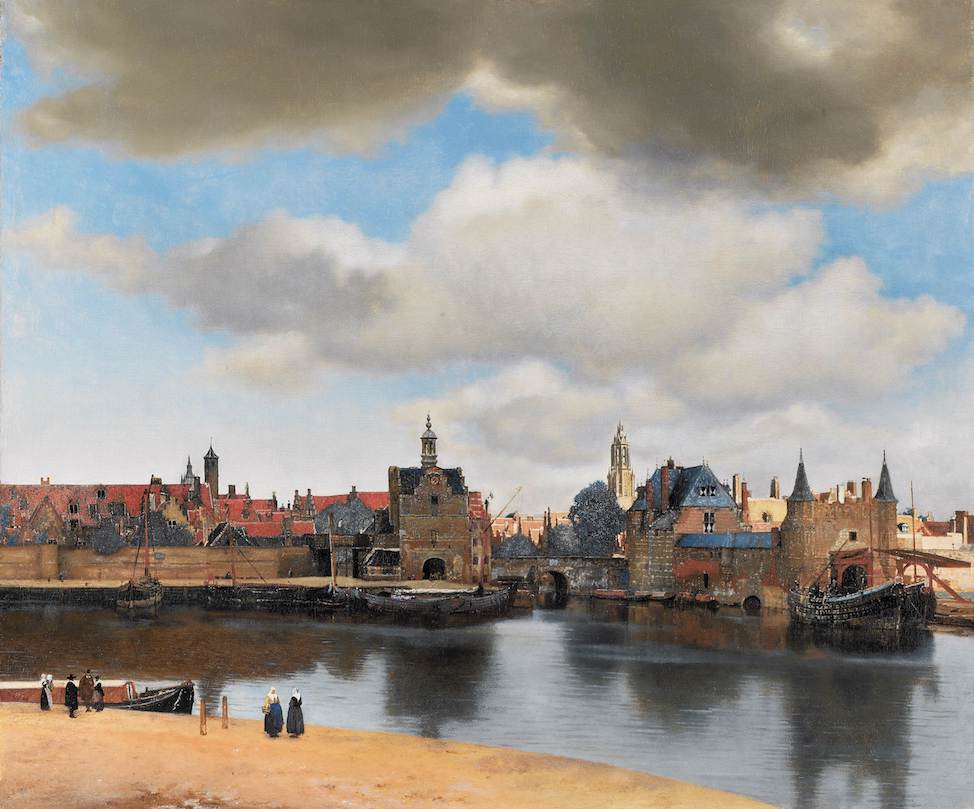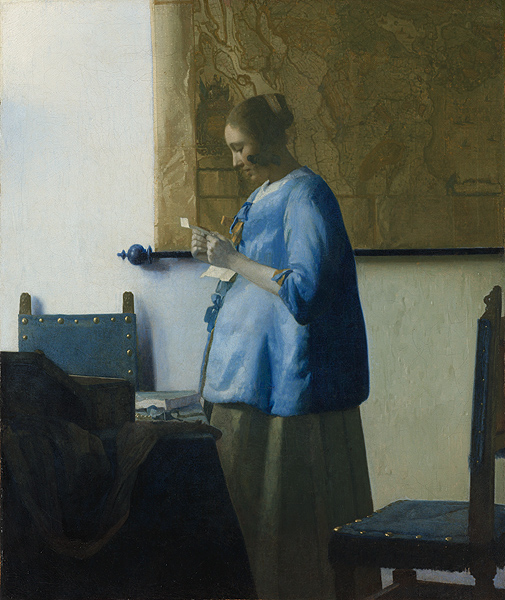Heard in Vermeer
by Hoyt Rogers
Ekphrasis | Pearl | Street | Milk | View | Letter
Ekphrasis: Words Heard in Vermeer
Though I had looked at Vermeer’s paintings in art books from early childhood, at age seventeen I met them in person—the phrase seems appropriate, since they depict people at varying distances from the viewer, mostly close-up. First I encountered the pictures located today in Anglophone countries and France; later I got to know the ones I like best, all still conserved in the Netherlands. Five of the latter, two from the Mauritshuis and three from the Rijksmuseum, serve as the ostensible themes of the five poems, Heard in Vermeer. I use the term “ostensible” because so much has been written about these canvases that there is little left to add beyond the reactions of each individual, by definition unique. In that sense, thousands of perspectives open up each day, as museum-goers examine the works; in addition, each renewed acquaintance with a Vermeer takes on another shading, according to the viewer’s circumstances and moods. The verses that follow correspond to the words that took shape in my mind, sometimes quickly, sometimes slowly, as I contemplated the paintings for hours on end. As offshoots of visual art, they issue from the age-old tradition of ekphrastic poetry.
A celebrated dictum from the Ars Poetica of Horace, “ut pictura poesis” (“as is painting, so is poetry”), has guided writers for centuries. It has generally been interpreted to mean that they should offer the reader portrayals as detailed and lifelike as those of the visual arts. Long before the ancient Romans, Simonides of Ceos, the Greek lyric poet, had proposed a similar idea. “Painting is silent poetry,” he declared, “and poetry is painting with the gift of speech.” Still, Horace’s lapidary formula, so often cited, has proved more influential—especially in the Renaissance and Baroque—as part of a larger debate about mimesis, both in literature and in art. Yet it is not only nature or “reality” that they imitate, but each other as well: literature can engender art (usually figurative art) and art can inspire literature. In a related device of rhetoric, ekphrasis, the author minutely describes an artwork, converting into words what the eye would normally see; the quintessential example is a passage from the Iliad, Book 18, where Homer “depicts” the ornate images on the shield of Achilles, fashioned by Hephaestus of bronze, tin, silver, and gold.
This begs several questions: Is any form of poetry based on “reality” as opposed to art? Don’t we automatically edit what we discern? Isn’t what we call “nature” merely a series of pictures within our brains from the outset? If that is so, then ekphrasis takes the phenomenon one step further, so we witness existence from a third remove. Of all artists, Vermeer provides the ideal portal for our successive stages of attachment and detachment. It has often been remarked that even his liveliest scenes appear arrested for all eternity. Despite the familiar objects and everyday occupations—pouring milk or reading a letter—they give the expression “still life” a whole new resonance. We enter this world in awe that it is so much like our own, yet subtly transfigured. The vanity of our ambitions falls away before the splendor of being itself, even if it is only an illusion. In Proust, the writer Bergotte feels overwhelmed by Vermeer’s View of Delft; he focuses on a small yellow wall (or more likely, roof) at the moment of his death, convinced that it discredits his entire oeuvre. Less drastically, in the fourth poem of my sequence I evoke how that same sunlit patch “updrafts us,” how it “glimmers like a shard projected / from the beach.” For me, it is quietly salvific, like everything painted by Vermeer.
Proust could aptly be called the poet of French prose, and his reverence for Vermeer is well-attested. As a rule, Francophone poets have devoted much more attention to the visual arts than their counterparts in our language. Baudelaire, often considered the father of modern art criticism, wrote extensively on Eugène Delacroix, the various salons, and humor in the arts. Mallarmé composed jewel-like ‘medallions’ of Whistler, Manet and Berthe Morisot; with Renoir, he was photographed by Degas. In our time, these poets’ heirs (such as Yves Bonnefoy, André du Bouchet, and Jacques Dupin) have allied themselves with painters even more strongly—not only through essays on their works but also through hybrids of the graphic and the verbal, such as art-books or portfolios of engravings and texts. Naturally, there are some important exceptions to what I just posited about English-speaking poets: Keats’s “Ode to a Grecian Urn” would stand as the classic rebuttal to my assertion. In recent times, Frank O’Hara and John Ashbery produced many essays on art for catalogues and reviews. Like Keats, some of our contemporaries have devoted poems to individual works; Auden’s “Musée des Beaux Arts” or Schulman’s “The Paintings of Our Lives” spring to mind.
In Keats, Auden, and Schulman, images furnish a point of departure for larger truths, rather than the granular ekphrasis I have drawn from Vermeer (as well as from Claesz and Tintoretto, in similar cycles of verse). Though I met Auden only once, I have known Grace Schulman for decades; without a doubt, her poetry ranks among the finest in our era. I sent her my Vermeer pieces as soon as I finished the first drafts; in an exchange of a dozen messages, she showed her usual kindness. She recalled that ekphrasis derives from the Greek verb “ekphrasein”: to tell, to recount. “At times I feel the speaker is Vermeer,” she noted; “at other times, the painting itself.” In my reply, I explained the ambiguity as follows: “I suppose the original human viewer of the scene was the painter. But I wasn’t concerned with the act of painting, more with what the light opens up to its own ‘gaze’—and by extension, to ours.“ After further discussion and several revisions, I sought to clarify that we who are looking at the work are the main protagonists. But because our engagement is so intense, we also identify with the painter, the subject, the shapes and colors, and even the light: strangely, our vision seems to suffuse the imaginary space like the light itself. As we concentrate on a painting, our awareness becomes enlarged and objectified. “While I don’t want the reader to end up befuddled,” I wrote to her, “I do want to retain that sense of a gradual widening from narrowness to infinity. If I can convey that to some degree, however modest, I will have reached my goal.” In my own experience—often repeated—the viewer, the painter, the things depicted, and the luminosity of the picture merge into one.
Grace’s words about my shifting lyric stance set me thinking. Unconsciously, by following the dictate of the paintings just as I saw them, I had stumbled upon their ultimate verity, as far as I was concerned: what I would call their visual polyphony. Each of them spoke to me in a multitude of voices that wove in and out of an overarching harmony—concomitant with the light, like colors refracted by a prism. The impression was enhanced by the fact that several times I visited the Dutch museums with fellow art-lovers, one from Venice and one from the Caribbean. An interlacing of comments—more like a passacaglia over a ground-bass of central themes—arose as we stood before the artworks. I remember Michele praising the extreme simplicity of Vermeer’s technique in Girl With a Pearl Earring, and how it relies on a limited palette an Italian might have spoiled, by saturating the tones with too many nuances. I remember him suggesting that because of its complex immobility, View of Delft offers us “a still-life as vast as a landscape.” I remember Pablo observing that the picture couples dark and light unevenly, in the radiance cast from above like a giant net. I remember him surprising me with the offhand statement that soon, the sky will tumble into the canal as drops of rain.
Of course, the voices I heard were all in my head, as soon as I pored over the canvases on my own. After I had written Heard in Vermeer, I returned to View of Delft only to discover that I still needed to explore it more thoroughly, like a country stretching off toward new horizons. Brick by brick, tile by tile, leaf by leaf, a glitter of pale blue seeps through the reds, yellows, and greens, as beaded as a wash of mercury. The city is dwarfed by the sky, which occupies well over half the picture space: tilting upward, its blue gradations grow darker and darker, mimicking the white to cream to gray to black of the clouds. Paradoxically, the rain-clouds lean toward us as they surge above the cityscape, drawing us down into its hidden pools of light. Delft floats between water and sky, both a workaday world and a celestial Jerusalem, much as it must have seemed to Vermeer. Ships unload their wares in the harbor, purveying the goods for merchants to buy and sell; citizens go about their business, pausing to chat on the quays. Even so, everything and everyone is only a reflection on the water; everything and everyone is just a spot or two of color, an apparition on the canvas. The painting itself is no more than some words heard in passing, suspended between then and now. Besides the fusion of earth and sky, light and dark, surface and depth, the fourth alloy forged by Vermeer is the most mysterious: the union of time with timelessness.
Johannes Vermeer, Girl with a Pearl Earring, 1665,
Oil on canvas, 1'6" x 1'3"
Mauritshuis, The Hague, Netherlands>
Pearl
You turn to me
to ask who I am,
as if your candor
might be distrust,
though you confer
the turban’s gloss
of yellows and blues,
the robe’s ochre sky,
the white that sidles
into gray, the bogus
pearl where I mirror
myself, unperturbed
that you are an ideal,
a type, a cold cliché
with lips too scarlet
and lemur-like eyes,
an alabaster cameo
carved by my twin
the supple shadow
into cheeks, nose,
chin, brows, neck:
even so, I ask you
to question me
to let me touch
your skin, hear
me answer you
yes I am the seer
and you the seen
indivisible as we
quieten your fears
uncloud your gaze
brighten your face
into light
speaking
with light.
Johannes Vermeer, The Little Street, 1657-1658
Oil on canvas, 1'9" x 1'5"
Rijksmuseum, Amsterdam, Netherlands
Street
I trek from far-off
to tilt you slightly,
street of ruddy bricks
and weathered wood
on which I linger at noon
to watch my companions:
an aunt sewing at her door,
a neighbor pottering
in a sunny alleyway,
a young girl, yellow
on checkers of stone,
crouching to conspire
with a question-mark,
the blue clematis
daring to oppose
its bridal arabesque
to the prim shutters
of clotted oxblood, gray
or black-hinged celadon,
the smug walls and roofs
that invalidate the clouds,
stepping back in wedges
smudged with pale caulk
like water turning white
as I walk on each figure
and shingle, snoop
behind each crease
to see what secrets
you hide, but find
none at all, divine
no resistance here
to my patient,
forgiving eye.
Johannes Vermeer, The Milkmaid, 1657-1658,
Oil on canvas, 1'6" x 1'4"
Rijksmuseum, Amsterdam, Netherlands
Milk
We are alone in a room
where you serve no one
but yourself, and we crave
nothing more, nothing less
than a crust of time
and space, a crumb
of the bread-chunks
at rest on the table,
or the loaf lying plump
in its openwork basket,
round as yourself, your
arms and forehead and
waist, snug in the scullery
where I trickle like milk,
an officiant
who is light,
crowning your head
with a cap of white,
anointing your body
with royal blue, crimson,
yellow, and gilded green,
bidding the work-scarred
wall to swell with wicker
and brass, but granting
to you the deepest blue
that gleams from the other
jar, all over you and every
inch of cloth, that osmoses
into burnt umbers and reds,
tweaks Cupid and the fisher
on the cracked tiles
of a city we ignore,
happy to idolize
the foot-warmer
comforting you,
the earthen bowl
you carefully fill
as from the left
I rain my praise
since you alone
are the monarch
of this hour,
of this place.
Johannes Vermeer, View of Delft, 1660-1661,
Oil on canvas, 3'3" x 3'10"
Mauritshuis, The Hague, Netherlands
View
Cleared of rooms, of streets
we unleash the far-flung city
and the clouds, like clouds
ourselves above the shore
below us, drinking it till
we absorb its closeness,
the figures on mellow sand
not ladies or pensive maids
framed by plaster, jambs
but tiny, faceless ciphers,
and those along the quays
of the silent town no more
than specks hardly visible
across the reddish pewter
canal, its vague reflections
of steeples, turrets, or trees
softly blurred by a breath
of rippling air, even if all
the barges and stout ships
are motionless, their sails
furled, their black, curved
hulls sitting like old shoes
on a varnished, faded floor
we are painting once more,
reserving our prime and last
light for the sandbank below,
the farthest gables, stitching
blue, green, fawn, white, red
tiles and facades, to pinpoint
near as remote, there as here
even if
inching
to the center a bridge re-joins
what only seemed to lie apart,
and other arches mime
that mouth, aspiring us
like water under stone
so that we drift toward
the unseen, until a high
yellow wall updrafts us,
glimmers like a shard projected
from the beach, toppling ledges
of gold to the right that to the
left rise in a spire once again,
and we stare up at the clouds as
no one ever did along the lanes,
their woolly white suddenly graver
than the hard blue sky, their murky
prow surging forward like a word
we’d barely understood until now,
floating above what wilder sight
would dream, and we know this
same view unscrolls for us again
and again, exactly as it has, does,
and always will, stillness falling
slowly out of time until it settles
here into the gray water’s sheen,
the never-changing page of glass.
Johannes Vermeer, Woman Reading a Letter, 1663-1664,
Oil on canvas, 18 5/16" x 15 3/8"
Rijksmuseum, Amsterdam, Netherlands
Letter
Every morning you stand
before this upper window
where I fall, if fall is not
for me too violent a verb
since I merely lean
over the sill to dew
your skin
with gray
and blue, to turn
this untidy table
the catty-cornered
chairs, naked wall
the picture-rod into
a placid azure lake,
and center you as sky
born anew from dead
mottled countries
on wrinkled maps
but then I seep
further inward
till I saturate
that shadow
you become
by rereading
the safe
ordinary
things I daily
write for you
in letters that blaze
from a nearby star
you see
as light.
Hoyt Rogers “is a writer, translator, scholar, and internationalist. Born in North America, he has spent most of his life in Latin America and Western Europe. He was educated at Columbia, Harvard, the Sorbonne, and Oxford, where he received his doctoral degree in 1978. He has published many books; he has contributed poetry, fiction, essays, and translations to a wide variety of periodicals.” To find out more about the man and his work pay a visit to his website, hoytrogers.com, and spend time there.
